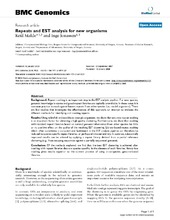Repeats and EST analysis for new organisms
Journal article
Permanent lenke
https://hdl.handle.net/1956/2687Utgivelsesdato
2008-01-18Metadata
Vis full innførselSamlinger
Originalversjon
https://doi.org/10.1186/1471-2164-9-23Sammendrag
Background Repeat masking is an important step in the EST analysis pipeline. For new species, genomic knowledge is scarce and good repeat libraries are typically unavailable. In these cases it is common practice to mask against known repeats from other species (i.e., model organisms). There are few studies that investigate the effectiveness of this approach, or attempt to evaluate the different methods for identifying and masking repeats. Results Using zebrafish and medaka as example organisms, we show that accurate repeat masking is an important factor for obtaining a high quality clustering. Furthermore, we show that masking with standard repeat libraries based on curated genomic information from other species has little or no positive effect on the quality of the resulting EST clustering. Library based repeat masking which often constitutes a computational bottleneck in the EST analysis pipeline can therefore be reduced to species specific repeat libraries, or perhaps eliminated entirely. In contrast, substantially improved results can be achived by applying a repeat library derived from a partial reference clustering (e.g., from mapping sequences against a partially sequenced genome). Conclusion Of the methods explored, we find that the best EST clustering is achieved after masking with repeat libraries that are species specific. In the absence of such libraries, library-less masking gives results superior to the current practice of using cross-species, genome-based libraries.
